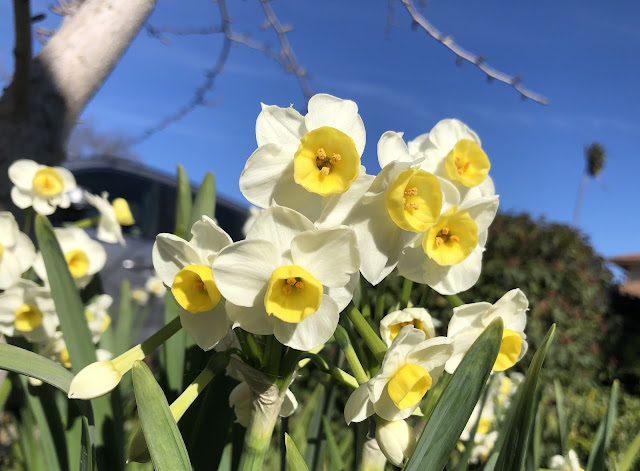
Weather forecast calls for 70s next week, but don't plant tomatoes yet

|
|
While much of the country is slogging through snow, we have blooming bulbs and blue skies. But it's
not spring yet. (Photo: Kathy Morrison)
|
Happy Groundhog Day! Just like Phil the Groundhog back in Punxsutawney, Pa., Sacramentans could see their shadow Tuesday morning under brilliant sunny skies.
Phil’s shadow sighting in Pennsylvania predicts, according to folklore, six more weeks of winter – not a welcome forecast for much of the country, which is digging out from too much snow.
Meanwhile, Sacramento – and the rest of Northern California – could use six more weeks of winter. Shadow or no shadow, we look like we’re headed for an early spring.
According to the National Weather Service, Sacramento could see highs of 67 degrees this weekend – 10 degrees above normal for early February. The long-range forecast predicts six days in the 70s next week.
Although that sun feels great to gardeners, those higher temperatures could bring out an explosion of fungal disease on roses and other susceptible plants. Watch out for powdery mildew.
Our dry streak continues, too, with no rain in Sacramento’s forecast until at least Feb. 17. That follows a January that recorded only 0.05 inches of precipitation. Like January, February’s average rain total is about 3.6 inches.
It may feel like spring, but don’t rush out and plant tomatoes. Overnight lows are still mighty chilly, dipping close to freezing Saturday and Sunday. Historically, Sacramento can still get frost as late as March 23. In addition, soil temperatures have to rise significantly for summer crops to sprout and grow.
This dry spell underlines that we’re still in an exceptional drought. Measurements this week in the Sierra show the snowpack is suffering, too. Although considered 100% of normal, the snowpack was 162% of normal in December; the snowpack shrank during January from lack of new snow.
Will we have a March miracle with lots of late rain? Accuweather says it’s possible. Its forecast predicts major storm systems closing out winter – but those clouds could bypass Northern California and rain on Washington and Oregon instead. A stormy April is possible, too.
Meanwhile, Sacramento-area gardeners can make the most of these sunny conditions with outdoor chores, but wait to plant summer vegetables until at least late March. It may not feel like it, but we’re still in winter – for at least six more weeks.
Comments
0 comments have been posted.Sacramento Digs Gardening to your inbox.
Sites We Like
Garden Checklist for week of July 21
Your garden needs you!
* Keep your vegetable garden watered, mulched and weeded. Water before 8 a.m. to reduce the chance of fungal infection and to conserve moisture.
* Feed vegetable plants bone meal, rock phosphate or other fertilizers high in phosphate to stimulate more blooms and fruiting. (But wait until daily high temperatures drop out of the 100s.)
* Don’t let tomatoes wilt or dry out completely. Give tomatoes a deep watering two to three times a week.
* Harvest vegetables promptly to encourage plants to produce more. Squash especially tends to grow rapidly in hot weather. Keep an eye on zucchini.
* Pinch back chrysanthemums for bushy plants and more flowers in September.
* Remove spent flowers from roses, daylilies and other bloomers as they finish flowering.
* Pinch off blooms from basil so the plant will grow more leaves.
* Cut back lavender after flowering to promote a second bloom.
* It's not too late to add a splash of color. Plant petunias, snapdragons, zinnias and marigolds.
* From seed, plant corn, pumpkins, radishes, winter squash and sunflowers.